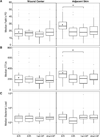Culture-independent pilot study of microbiota colonizing open fractures and association with severity, mechanism, location, and complication from presentation to early outpatient follow-up
- PMID: 24395335
- PMCID: PMC4418442
- DOI: 10.1002/jor.22578
Culture-independent pilot study of microbiota colonizing open fractures and association with severity, mechanism, location, and complication from presentation to early outpatient follow-up
Abstract
Precise identification of bacteria associated with post-injury infection, co-morbidities, and outcomes could have a tremendous impact in the management and treatment of open fractures. We characterized microbiota colonizing open fractures using culture-independent, high-throughput DNA sequencing of bacterial 16S ribosomal RNA genes, and analyzed those communities with respect to injury mechanism, severity, anatomical site, and infectious complications. Thirty subjects presenting to the Hospital of the University of Pennsylvania for acute care of open fractures were enrolled in a prospective cohort study. Microbiota was collected from wound center and adjacent skin upon presentation to the emergency department, intraoperatively, and at two outpatient follow-up visits at approximately 25 and 50 days following initial presentation. Bacterial community composition and diversity colonizing open fracture wounds became increasingly similar to adjacent skin microbiota with healing. Mechanism of injury, severity, complication, and location were all associated with various aspects of microbiota diversity and composition. The results of this pilot study demonstrate the diversity and dynamism of the open fracture microbiota, and their relationship to clinical variables. Validation of these preliminary findings in larger cohorts may lead to the identification of microbiome-based biomarkers of complication risk and/or to aid in management and treatment of open fractures.
Keywords: 16S rRNA; bacteria; infection; microbiome; open fracture.
© 2014 Orthopaedic Research Society. Published by Wiley Periodicals, Inc.
Figures




References
-
- Zalavras CG, Patzakis MJ, Holtom PD, et al. Management of open fractures. Infectious disease clinics of North America. 2005;19:915–929. - PubMed
-
- Burns TC, Stinner DJ, Mack AW, et al. Microbiology and injury characteristics in severe open tibia fractures from combat. The journal of trauma and acute care surgery. 2012;72:1062–1067. - PubMed
-
- Valenziano CP, Chattar-Cora D, O'Neill A, et al. Efficacy of primary wound cultures in long bone open extremity fractures: are they of any value? Archives of orthopaedic and trauma surgery. 2002;122:259–261. - PubMed
Publication types
MeSH terms
Grants and funding
LinkOut - more resources
Full Text Sources
Other Literature Sources
Medical

